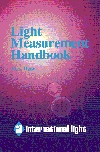 Choosing
Input Optics
Choosing
Input Optics Choosing
Input Optics
Choosing
Input OpticsSuppose, for example, that you were measuring the erythemal (sunburn) effect of the sun on human skin. While the sun may be considered very much a point source, skylight, refracted and reflected by the atmosphere, contributes significantly to the overall amount of light reaching the earth’s surface. Sunlight is a combination of a point source and a 2p steradian area source.
The skin, since it is relatively flat and diffuse, is an effective cosine receiver. It absorbs radiation in proportion to the incident angle of the light. An appropriate measurement system should also have a cosine response. If you aimed the detector directly at the sun and tracked the sun's path, you would be measuring the maximum irradiance. If, however, you wanted to measure the effect on a person laying on the beach, you might want the detector to face straight up, regardless of the sun’s position.
Different measurement geometries necessitate specialized input optics. Radiance and luminance measurements require a narrow viewing angle (< 4°) in order to satisfy the conditions underlying the measurement units. Power measurements, on the other hand, require a uniform response to radiation regardless of input angle to capture all light.
There may also be occasions when the need for additional signal or the
desire to exclude off-angle light affects the choice of input optics.
A high gain lens, for example, is often used to amplify a distant point
source. A detector can be calibrated to use any input optics as long
as they reflect the overall goal of the measurement.


